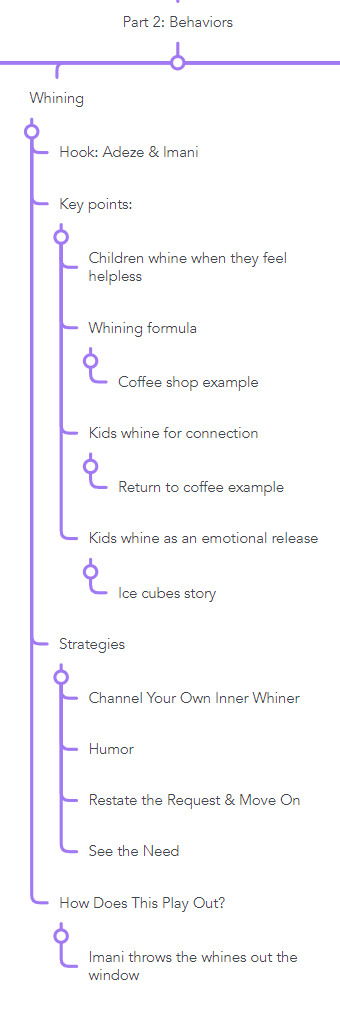Map a Book With Me! Part IV: Chapter Structure
Behind-the-Scenes of Good Inside by Dr. Becky Kennedy

It took us weeks to figure out that Jojo Siwa is a person.
We honestly thought our foster daughter was making up gibberish words. “Jojo Siwa” didn’t sound like a real name to us.
Turns out, we’re way behind the times, because Jojo Siwa was a kid pop star on Nickelodeon in the late ‘10s and is now, at 20 years old, a reality show regular. Who knew. Certainly not a couple in their mid-30s who have been out of touch with kid pop culture for the last 25 years. We might as well be dinosaurs now.
But in the last month, we’ve gotten caught up to speed on all things Jojo Siwa. Our foster daughter is OBSESSED with her.
She wants her hair like Jojo Siwa. She wants to wear bright colors and dance like Jojo Siwa. She now has a glittery Jojo Siwa backpack. Her love of Jojo Siwa is only rivaled by her love for Bluey (who we had heard of).
One of the many unique challenges that kids in foster care face is being forced to code switch constantly, to walk between worlds. In one world, you have one set of parents and one community and one set of expectations. In the other world, you have a completely different set of parent figures and community and expectations. It’s confusing and disorienting to say the least, especially for one so young seeking stability and comfort. Seeking constantly to know, who am I?
We realized that we needed a way to help her navigate this process, to help her with the reentry back to our home and our routines and re-regulate herself after making the hard journey from one world to ours.
So we became Team Jojo Siwa.
Team Jojo Siwa is kind to each other. Team Jojo Siwa tells the truth. Team Jojo Siwa shares things. Team Jojo Siwa apologizes when they mess up. Team Jojo Siwa gets up and gets dressed in the morning. We brush our teeth before we leave the house, and at night before bed. We eat dinner together. We laugh. We play games. We create safety and we fill our house with love.
She knows what it means to be Team Jojo Siwa.
Yesterday, she was unexpectedly met with a reminder of her other world—a confusing crash of contexts that sent her spinning, crying, reaching her arms out for us to help her understand what’s going on, why is this other person here in our home, why are they saying upsetting things, are you here, am I safe?
“Hey,” my husband said, holding her on the couch. “We’re Team Jojo Siwa, remember?” She smiled slightly and calmed down, snuggling in closer. All she needed was the reminder and the assurance that nothing had changed. We’re Team Jojo Siwa.
It’s when I see moments like this that I know we’re doing ok, even as brand-new parents. We mess up for sure. But we’re doing a few things right, too.
We are good. And that’s the main thing Dr. Becky’s book wants us to know.
I’m in the process of mapping out Dr. Becky Kennedy’s outstanding book, Good Inside: A Guide to Becoming the Parent You Want to Be, so that I can better understand and remember all of the incredible content within this book. So that I can be better and do better as a parent.
Last Friday, we found the audience, genre, and Big Idea of the book, which provide the context for the mapping we are about to begin (Part I). In Part II, we discussed the transformation tale. Part III was about how to turn the nebulous, brainstormy “in between” into an organized Table of Contents.
And today, we’re diving into the details to see what it might look like to map out just one chapter.
Step #4: Chapter Structure
One thing we talked about in my last post was that there are actually two kinds of chapters going on in this book—hence, there are two Parts to the book. Dr. Becky’s Part I is about her parenting principles, the basic philosophical ideas she wants her reader to understand about parenting in general. Part II is about applying those principles to specific behavior challenges that parents often face.
As you might imagine, the structure for these two different kinds of chapters is going to be different.
For the purposes of this post, I’m going to use one of the more practical chapters in Part II, because I think it’s easier for you to see a clear, repeatable structure here. In fact, if we look at all of the chapters in Part II, we see that Dr. Becky was following a simple, engaging template. Coming up with a chapter template for yourself is one of the best pieces of advice I give authors.
Here’s the chapter template for Part II of Good Inside:
[Hook] Parenting scenario
Each starts with a realistic scenario describing the behavioral problem of that chapter, featuring kids and parents. These scenarios might be real using real kids’ names or pseudonyms, they might be completely made up, or they could be a fictional composite based on reality. The scenario is set apart from the rest of the text, inside a boxed feature underneath the Chapter header.
[Exposition]
After the scenario, Dr. Becky explains what’s really going on when this behavioral challenge arises. She explains what we need to reframe for ourselves as parents and how we could begin to approach this behavior differently.
[Strategies]
After making her case, Dr. Becky provides specific strategies (under clear and helpful subheadings!) for parents to try when the unwanted behavior arises. She sometimes provides examples and scripts to help, too. These sections are the most practical, actionable pieces of the book.
[Conclusion] How Does This Play Out for [NAME]?
She returns to the hook at the beginning of the chapter and describes what it would look like for the parent in that scenario to respond using one of the strategies she just described. It’s an effective and compelling preview of the transformation the reader too might experience when they implement these ideas in their own lives.
Here’s what it looks like more specifically with Ch. 17: Whining:
[Hook] Child Adeze complaining and whining to her mom, Imani, who feels immediately triggered and overwhelmed by the whining.
[Exposition] Dr. Becky pretty quickly reframes what’s going on and helps us understand, “Children whine when they feel helpless” (p. 187). In fact, she has a helpful formula for understanding whining: Whining = strong desire + helplessness. She offers examples that illustrate the formula, and explains why these situations may be triggering for parents. She also provides other reasons and contexts for why kids may be whining.
[Strategies]
Dr. Becky provides four practical strategies for responding to whining, each under their own headings:
Channel Your Own Inner Whiner
Humor
Restate the Request in Your Own Voice and Move On
See the Need
[Conclusion] How Does This Play Out for Adeze and Imani?
The scenario from the beginning of the chapter is concluded, showing how Imani chooses humor to respond to Adeze’s whining and releases some of her own frustrated energy by moving her body.
The end! This chapter ends without an explicit transition to the next chapter, as I often suggest, but that’s ok—it’s really not needed.
If I were mapping this out on MindMeister with Dr. Becky, here’s how it would look:
I hope this series has been super helpful to you. If you have any questions about book mapping, let me know in the comments. And if you’re interested in getting help creating a book map for your own book, learn more about our next Map Your Book cohort in May!
Tips & Tidbits
The Ethics of Writing & Posting About Your Kids
Throughout this series, I’ve debated how much to share and what. I’ve tried to maintain the lens of my own experience and internal transformation, rather than posting outright about my foster daughter—the same standards we set for memoir writers. And yet, I wonder about the ethics of what I’m sharing. Is it right for me to share anything at all about her, without her consent? I’m still pondering and considering this, and I appreciate this piece from Ryan Holiday about how he and his wife handle it for their family.
Sign Posting to Write More Clearly
Becoming an Expert Writer
My friend Dave Stuart Jr. is an incredible writer and thinker. Case in point: This article, “The Expert Equation” gave words to the challenge I see many writers have with building expertise as writers. Just replace the word “students” with “writers” throughout the article, and pretty much everything applies.
Why Building a Platform Doesn’t Work
I and many of my friends noticed recently that with Instagram particularly, we were putting in more and more resources (paying for ads) and getting less and less of a return (more followers) in an attempt to “grow our platform.” This is in large part why I stopped being Meta Verified and stopped paying for Instagram ads late last year. Anyway, this excellent article from Tara McMullin describes why self-promotion isn’t helping us build a platform anyway.
What’s Bringing Me Joy
We had a successful night out last night with some new friends—and it went great! I’m so grateful we have good neighbors and friends who help us out and love on our kids.
Have a great weekend!
Ariel




